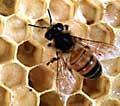Bees in laboratories

Both studies have recently given rise to new information about bees whose results have been published jointly in the journals Nature and Science. On the one hand, they have completed the ambitious project of decoding the bee genome. On the other hand, a fossil bee trapped in amber has been studied and new data on the evolution of these insects have been known, with the
largest project being the bee genome. It consists of 10,157 genes, along with regulatory points that control gene activities. To analyze this, 170 scientists have participated in the project who have found very interesting things such as the importance of regulating centers in the social behavior of the bee. On the other hand, important genes have been found such as those that encode smell receptors and those they use to create
royal jelly. It was discovered in Burma and some scientists bought it. Once purchased, the fossil was analyzed and realized that it is the oldest pollinator known. The fossil gives a mixture between a bee and a wasp: the pair of central legs looks like a wasp, but has pelillos like a bee. According to scientists, it collected pollen from flowers 100 million years ago, 40 million years before the oldest pollen known so far.
Photo: Jeff Pettis
Buletina
Bidali zure helbide elektronikoa eta jaso asteroko buletina zure sarrera-ontzian











